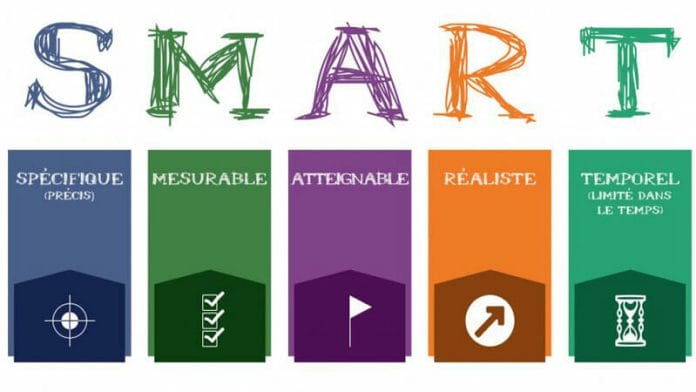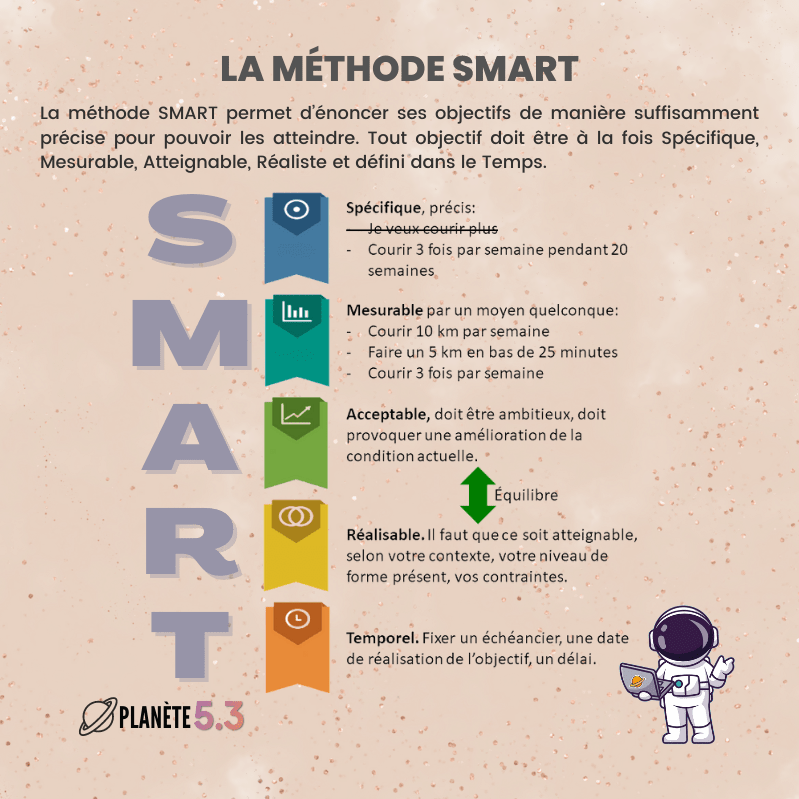At work and on a personal level, people who set specific goals are more likely to succeed than those who have poorly defined goals. The reason is simple: by defining a specific objective, we already establish a roadmap to achieve it. SMART objective example…
When it comes to well-being, physical activity, at work and in life in general, it is crucial to set goals as clearly as possible that we want to achieve in order to be able to achieve them. This is an indispensable prerequisite.
SMART acronym: how to set a goal?
According to American psychologist Jonathan Freedman, setting short and long term goals makes you happier. By realizing them, we realize ourselves! This gives meaning to life, structures daily life, strengthens social relationships and allows us to better overcome difficulties.
Richard Davidson, a neurobiologist at the University of Wisconsin, has even argued that aiming for a goal and achieving it wards off the risk of depression.
Always favor the short term by determining concrete actions that you can take. Gradually redefine the medium and long-term objectives if necessary. Priority must be given to the short term. Focus on the essential, on the concrete. The short term represents the moment of action. Start small and little by little you will progress in achieving your goals.
SMART goal example
To properly set a short-term goal,a SMART method has proven itself. It allows you to state your objectives in a sufficiently precise and intelligent way to be able to achieve them.
According to this method popularized by its brilliant acronym, any objective must be:
- Specific,
- Measurable,
- reachable,
- Realistic,
- Temporally defined.

The smart method
The SMART indicator is based on quantitative objectives and can be illustrated by an example of an action plan
1. Your goal must be Specific
A goal should be clear and accurate. It has to fit in one sentence and even someone who doesn’t know you must be able to understand what it is. And when you express the objective in black and white, one must also easily grasp how it can fail. Simplicity is synonymous with efficiency.
SMART goal example : if you say so “get back in shape”, it remains very vague and general. A specific objective would rather be expressed as follows: Join a gym and train 3 times a week for 90 minutes, Tuesday, Thursday and Saturday. »
2. Your professional goal or not must be Measurable
A goal can only exist if it is measurable, otherwise it is impossible toevaluate the results of efforts what you have accomplished. For track your progressyou need figures otherwise you will settle for a subjective assessment when in reality, the objective will not be achieved.
SMART goal example : there should always be a number in your goal statement, otherwise it’s probably not a SMART goal. Lose 10 kilos, recruit 5 clients, run a marathon (which means a distance of 42,195 kilometres)… As long as the number is not reached, the objective is not achieved.
3. Your goal must be Achievable
Your goal must be achievable, which means it can be “ambitious” and motivating but especially not out of reach, otherwise you will probably give up soon enough. The key question to ask yourself is: “Is it possible for me to achieve this objective with my physical qualities, my intellectual resources, my financial means, etc.? ? »
Start small, your goal should be fair challenging enough to stimulate you. You can always increase the difficulty level later, if you wish. The notion of progression is a powerful motivator.
SMART goal example : if your goal is to participate in a marathon within 3 months and you haven’t run for 10 years, this is not an attainable goal. This is a dream ! fix yourself the achievable goal to run 10 km within 2 months and start your training modestly by running 5 km three times a week.
4. Your Goal Must Be Realistic
An attainable goal and a realistic goal are two different things. A goal may be achievable, therefore “doable”, but unrealistic given the particular context in which you operate or efforts you are willing to make to succeed.
It is your age, your availability, your family and professional obligations and your lifestyle that will help you determine the realism of your project.

To develop and maintain your sense of well-being, discover our mini-program 10 Small Happiness Steps : an Email every morning for 10 days!
Click here to get it for free
SMART goal example : If your goal is to learn to play the guitar in six months (at a basic level), it is possible! The goal is attainable as long as you have the necessary motivation.
If you intend to practice 30 minutes a day on your instrument, with a teacher or sometimes alone, the goal becomes realistic because you give yourself the means to achieve it. If, on the other hand, you devote yourself to it one hour a week, the conditions for your success are not met: your project is not realistic.
5. Your goal must be set in time
To be SMART, an objective must be time-bound, that is to say, it must have a duration and therefore a date of accomplishment. When should your goal be reached? If you don’t set a deadline, it will be difficult for you to plan your efforts over time. This is essential to properly track your progress. The temporal aspect of an objective is intrinsically part of its definition.
SMART goal example : We can take the example of a weight loss goal which is the most telling: “ I want to lose 10 kg in two months“. This means that from the day you start, you will have 9 full weeks to reach your goal of 10 kg lost. This corresponds to 1.1 kg per week.
You will be able to evaluate your “passage times” each week based on linear weight loss during these two months of diet. For example, if you have lost 3.8 kg after 3 weeks, you are ahead of your goal.
Read also:
The right method to succeed in everything you do
How to achieve your goals this year?
The objective, an essential notion when you want to lose weight
10 great ideas to boost your physical activity
How to set a SMART goal?
















